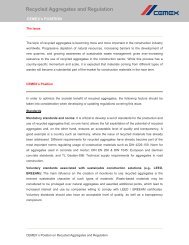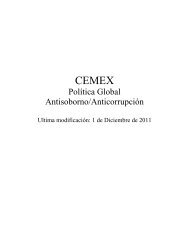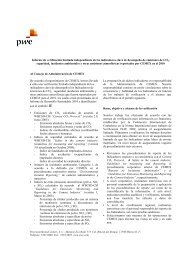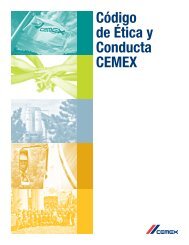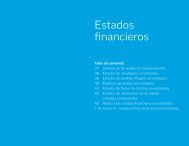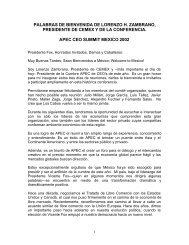building a STRONGER foundation - Cemex
building a STRONGER foundation - Cemex
building a STRONGER foundation - Cemex
You also want an ePaper? Increase the reach of your titles
YUMPU automatically turns print PDFs into web optimized ePapers that Google loves.
Interest Rate Risk, Foreign Currency Risk and Equity Risk<br />
Interest Rate Risk. The table below presents tabular information of our fixed and floating rate long-term foreign currencydenominated<br />
debt as of December 31, 2010. See note 12A to our consolidated financial statements included elsewhere in this annual<br />
report. Average floating interest rates are calculated based on forward rates in the yield curve as of December 31, 2010. Future cash<br />
flows represent contractual principal payments. The fair value of our floating rate long-term debt is determined by discounting future<br />
cash flows using borrowing rates available to us as of December 31, 2010 and is summarized as follows:<br />
126<br />
Expected maturity dates as of December 31, 2010<br />
Long-Term Debt(1) 2011 2012 2013 2014<br />
After<br />
2015 Total<br />
Variable rate................................................................. 313 1,008 2,262 6,472 14 10,069 10,039<br />
Average interest rate .................................................... 4.44% 6.38% 7.27% 5.54% 6.39%<br />
Fixed rate ..................................................................... 96 155 152 1,615 4,275 6,294 6,271<br />
Average interest rate .................................................... 8.29% 8.24% 9.16% 9.29% 5.98%<br />
(1) The information above includes the current maturities of the long-term debt. Total long-term debt as of December 31, 2010 does<br />
not include the perpetual debentures for an aggregate amount of U.S.$1,320 million (approximately Ps16,310 million), issued by<br />
consolidated entities. See note 16D to our consolidated financial statements included elsewhere in this annual report.<br />
As of December 31, 2010, we were subject to the volatility of the floating interest rates, which, if such rates were to increase,<br />
may adversely affect our financing cost and our net income. As of December 31, 2010, 62% of our foreign currency-denominated<br />
long-term debt bears floating rates at a weighted average interest rate of LIBOR plus 418 basis points.<br />
Foreign Currency Risk. Due to our geographic diversification, our revenues are generated in various countries and settled in<br />
different currencies. However, some of our production costs, including fuel and energy, and some of our cement prices, are<br />
periodically adjusted to take into account fluctuations in the Dollar/Peso exchange rate. For the year ended December 31, 2010,<br />
approximately 23% of our net sales, before eliminations resulting from consolidation, were generated in Mexico, 17% in the United<br />
States, 4% in Spain, 8% in the United Kingdom, 7% in Germany, 7% in France, 7% in our Rest of Europe geographic segment, 11%<br />
in South America, Central America and the Caribbean, 8% in Africa and the Middle East, 4% in Asia and 4% from other regions and<br />
our cement and clinker trading activities. As of December 31, 2010, after giving pro forma effect to (1) the issuance of the January<br />
2011 Notes, the 2011 Optional Convertible Subordinated Notes and the April 2011 Notes, (2) the 2011 Prepayments and (3) the 2011<br />
Private Exchange, approximately 75% of our consolidated debt was Dollar-denominated, approximately 4% was Peso-denominated,<br />
approximately 21% was Euro-denominated and immaterial amounts were denominated in other currencies, without including<br />
approximately U.S.$1,160 million (Ps14,342 million) of notes issued in connection with the Perpetual Debentures; therefore, we had a<br />
foreign currency exposure arising from the Dollar-denominated debt, and the Euro-denominated debt, versus the currencies in which<br />
our revenues are settled in most countries in which we operate. See “— Liquidity and Capital Resources — Our Indebtedness” and<br />
“Item 3 — Key Information — Risk Factors — We have to service our Dollar-denominated obligations with revenues generated in<br />
Pesos or other currencies, as we do not generate sufficient revenue in Dollars from our operations to service all our Dollardenominated<br />
obligations. This could adversely affect our ability to service our obligations in the event of a devaluation or depreciation<br />
in the value of the Peso, or any of the other currencies of the countries in which we operate, compared to the Dollar. In addition, our<br />
consolidated reported results and outstanding indebtedness are significantly affected by fluctuations in exchange rates between the<br />
Peso and other currencies.” In addition, as of December 31, 2010, our Euro-denominated debt, after giving pro forma effect to (1) the<br />
issuance of the January 2011 Notes, the 2011 Optional Convertible Subordinated Notes and the April 2011 Notes, (2) the 2011<br />
Prepayments, and (3) the 2011 Private Exchange, represented approximately 21% of our total debt, not including approximately<br />
€147 million aggregate principal amount of the 6.277% Perpetual Debentures outstanding after the completion of the 2010 Exchange<br />
Offer and the 2011 Private Exchange. We cannot guarantee that we will generate sufficient revenues in Euros from our operations in<br />
Spain and the Rest of Europe to service these obligations. As of December 31, 2010, all cross-currency swaps had been settled.<br />
Equity Risk. As described above, we have entered into equity forward contracts on AXTEL CPOs. Upon liquidation, the equity<br />
forward contracts provide cash settlement and the effects are recognized in the statement of operations. At maturity, if these forward<br />
contracts are not settled or replaced, or if we default on these agreements, our counterparties may sell the shares of the underlying<br />
contracts. Under these equity forward contracts, there is a direct relationship in the change in the fair value of the derivative with the<br />
change in value of the underlying asset.<br />
As of December 31, 2010, the potential change in the fair value of these contracts that would result from a hypothetical,<br />
instantaneous decrease of 10% in the market price of AXTEL CPOs would be a loss of approximately U.S.$7 million (Ps87 million).<br />
Fair<br />
Value



